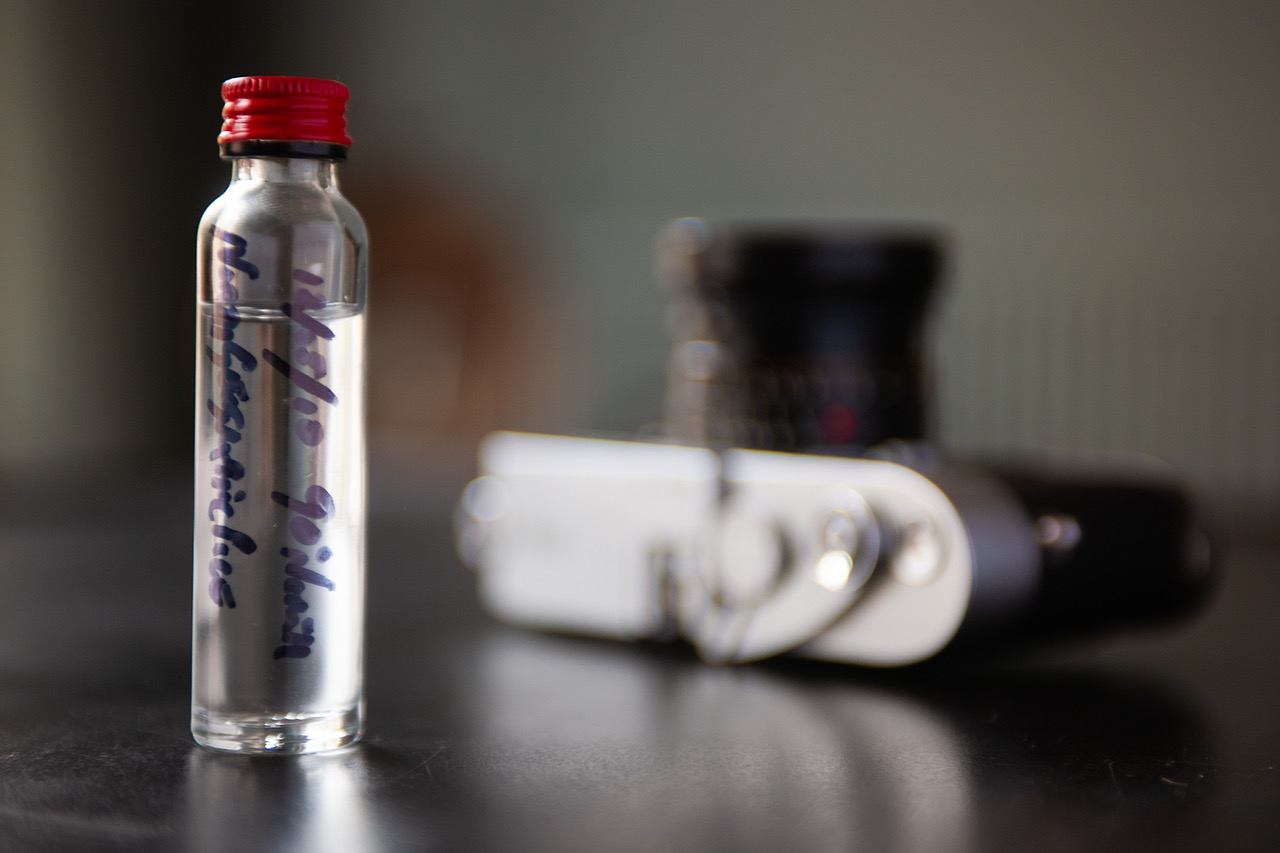28/04/2021
Back from the North Pole
the Leica MP 0.72 “Martin Hartley”
In 2010, expedition photographer Martin Hartley documented the Catlin Arctic Survey Project with his Leica MP 0.72. The camera – together with a 24mm Elmarit, two limited-edition prints, and a water sample collected at the North Pole – is now up for auction.

After a gruelling 60-day trek, the Catlin Arctic Survey Project team members, lead by Pen Hadow, reached the North Pole on May 12, 2010.
It was amidst extremely harsh conditions that the three-strong explorer team reached the geographic North Pole on May 12, 2010 – having completed a gruelling 60-day trek across the ever-dwindling Arctic sea ice. Renowned polar scientist and team leader Pen Hadow, his colleague Ann Daniels, and expedition photographer Martin Hartley, had embarked on this extraordinary mission to research the impact of climate change on the fragile ecosystem of the northern polar region. “Once you’ve left the plane and set off for the North Pole, there’s no turning back,” Hartley said in an interview with British author Sophy Roberts. “There’s practically no chance of a rescue mission.”
The environmental conditions posed a challenge not only for the team members, but also for the technical devices they relied upon. Choosing the right equipment, which in this case included the Leica MP 0.72, was paramount. With the ongoing decline of the Arctic ice, an expedition of this nature would barely be possible today – and even back in 2010, several passages of the journey had to be covered by swimming across areas of open water. In addition to travelling in temperatures as low as minus 45 degrees Celsius, a frequent southerly drift meant that the ice sheets shifted, and the team was pushed backwards every time they camped for the night. Just one year prior, another team had failed in their attempt to reach the pole. Hadow, Daniels and Hartley ultimately succeeded and drilled for water samples at the top of the world.

Traversing the Arctic sea ice was an incredibly challenging endeavour for the expedition team. Temperatures plummeted to minus 45 degrees Celsius – with the icy winds making it feel more like minus 75
“There is no modern camera that will work reliably in this environment,” Hartley explains. Power supply is perhaps the greatest issue surrounding digital equipment, as the low temperatures can prevent batteries from producing enough current; aperture blades can also fail to open and close properly, and the autofocus can lose accuracy. For this reason, Hartley – for whom this mission marked his 20th expedition to an Arctic or Antarctic region – decided on a camera that has been specifically tested for these challenging conditions, and which operates without a power supply. “I carried the Leica MP 0.72 around my neck in a thin waterproof bag,” Hartley recalls. This ensured that moisture from his breath could not land, and subsequently freeze, on the viewfinder. As a result “the camera was instantly accessible throughout the day, regardless of how cold it got.”
„Individualism that improves with age“ is how Leica describes its MP models
Now the seasoned expedition photographer has decided to pass his trusty companion on to a new owner. Most of today’s clients, he explains, are no longer willing to cover the cost of film, nor the time it takes to digitise the images at the end of a project. The Leica MP 0.72 has accompanied Hartley on numerous expeditions – and while it cuts a fine figure on his shelf, he feels it belongs out in the field. ‘Individualism that improves with age’ is how Leica describes its MP models, which enable skilled photographers to embrace analogue photography in the modern day. To facilitate ultimate creativity without distractions, the MP 0.72 (which has been in Leica’s product catalogue since 2003) is purely mechanical, with a primary focus on robust construction and uncompromising functionality. The camera features neither semi-automatic modes, nor an electronic shutter. It does, however, come with the legendary Leicavit rapid winder – a manual quick-wind device and film advance lever originally introduced to the M-System with the first Leica MP of 1956.
Designed as a heavy-duty reporter camera, the Leica MP 0.72 is distinguished by a number of special traits. These include a viewfinder system with tempered optical elements, a particularly clear viewfinder image and bright framelines, as well as an optimised shutter and film advance mechanism. When the MP 0.72 was launched in 2003, Leica Fotografie International wrote that the new camera stood for “precision mechanics in its purest form, and maximum stability.”

Martin Hartley’s name and the expedition dates have been engraved into the base plate of his Leica MP 0.72
When the MP 0.72 was launched in 2003, Leica Fotografie International wrote that the new camera stood for
„precision mechanics in its purest form, and maximum stability.“

12/5/10 90°North: the auction lot includes a small bottle filled with a water sample collected at the North Pole
The model to be auctioned – which features the engraving ‘Martin Hartley, 777KM Arctic Ocean Survey 2010, 90°00’ 0.00“N 12/05’ on the base cover – will be offered at the 38th Leitz Photographica Auction on June 12, 2021. The auction lot also includes Hartley’s Leica Elmarit-M 24 f/2.8 ASPH., along with two photographs from the expedition (each of which is limited to five prints worldwide), and a small bottle containing a water sample collected from a drill core at the geographic North Pole.
Photos: Martin Hartley
Text: Tobias F. Habura-Stern / LFI Leica Fotografie International